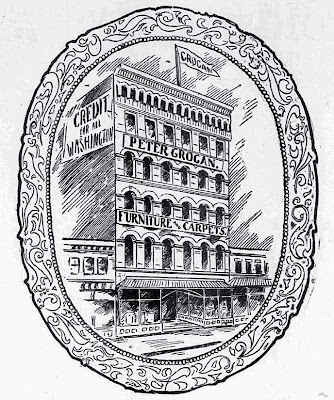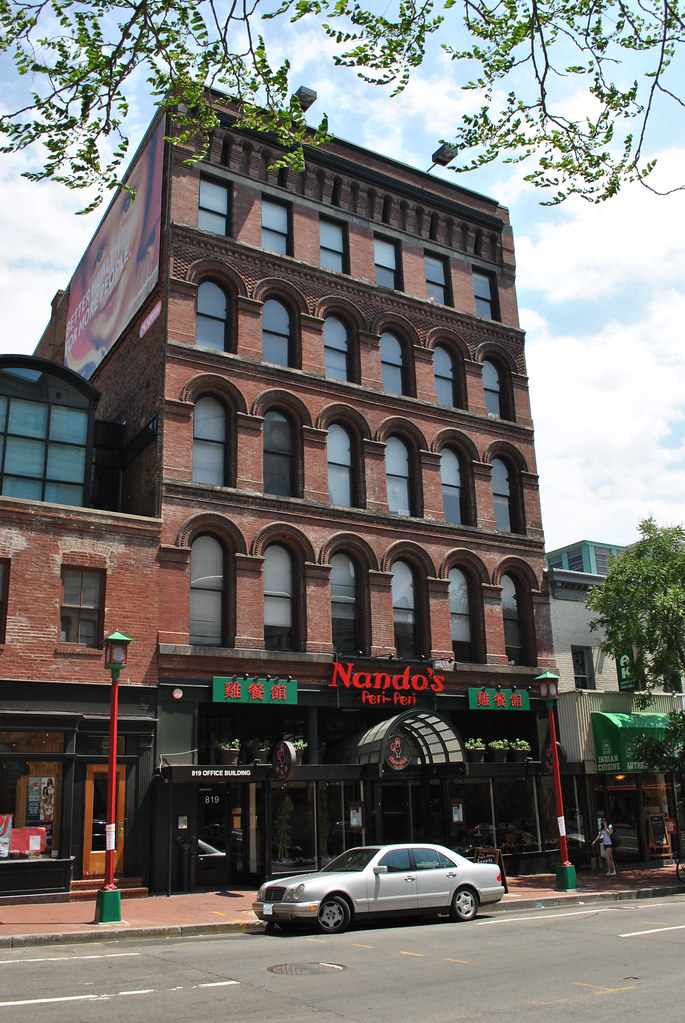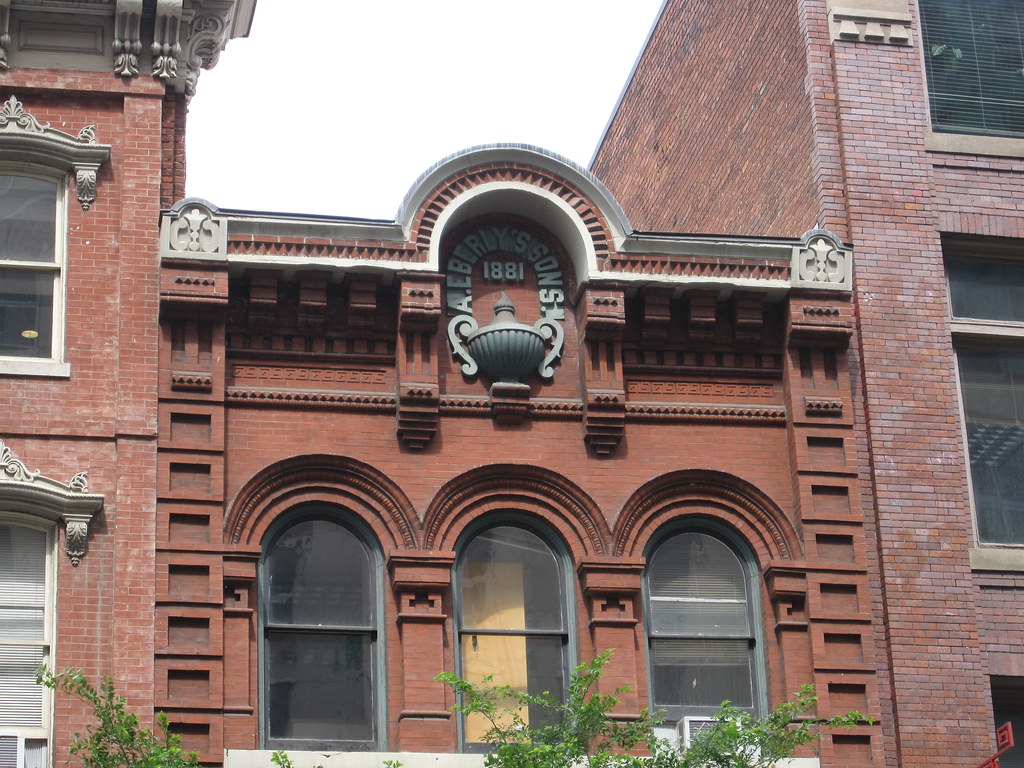Grogan's Furniture Store on 7th Street NW
 |
| Grogan's store, as seen in an advertisement in The Washington Bee, December 28, 1907 |
 |
| A view of the building as it appears today. |
Julius Germuiller (1859-1929), the architect of Grogan's store, was born in this neighborhood to German immigrants. His father operated a saddlery and harness business one block to the south of where the Grogan building was to be built. Germuiller is thought to have been self-taught as an architect, like many of his generation, and worked his whole career out of offices in this same part of the city. He was a prolific designer of row buildings--over 300 of them throughout Washington--that are distinguished for their intricate details and fine ornamentation in brick and terracotta. Another nearby commercial project of his, a corner drug store at 3rd and H Streets NW, is on the National Register of Historic Places.
For the Grogan store, Germuiller designed a typical but elegant five-story building in the Romanesque Revival style that towers over the other two- and three-story buildings in its block. Its graceful facade includes three neat rows of semi-circular arched windows with ornamental details of molded-brick and a corbelled brick cornice. As seen in these photographs, the interior spaces are wide open to allow for extensive displays of furniture, carpets, and, of course, "go-carts" (strollers).
Interior views of Peter Grogan's store, from an advertisement in The Washington Times, April 3, 1910.
Advertisements in newspapers in the 1900s and 1910s show Grogan emphasizing the affordability of his merchandise. "If your supply of ready cash is somewhat depleted, that fact has no bearing on the buying of furniture and housefurnishings--if you buy HERE," proclaimed an ad in The Colored American for February 13, 1904. "We take pride in arranging payments to suit the individual convenience of our patrons, and we make them so small that the money will scarcely be missed."
The approach seems to have worked. Grogan passed the business on to his three sons, who continued successfully until 1933, when the store finally closed in the midst of the Great Depression. Two years later, another furniture store, Peerless Furniture Company, moved in and was also successful for many years--until the next major cataclysm to affect the neighborhood, the riots of April 1968 following the assassination of Rev. Martin Luther King, Jr. Many blocks of 7th Street above Mount Vernon Square, where police set up a roadblock, were severely damaged. Although furniture row was not directly affected, businesses throughout this area were discouraged in the wake of the riots and began leaving. Peerless consolidated its retail operations at its store on upper Connecticut Avenue. Another major furniture dealer, John W. Miller, similarly consolidated his business at his store in Spring Valley. As reported in The Washington Post, two other furniture stores also abandoned the 7th Street strip.
Then in May 1969, Home Furniture and Appliance Company rented the former Peerless building with the promise of opening up a discount business aimed at "families with incomes below $9,000." Unfortunately, the store abruptly closed down three years later in financial disarray. The Post reported "literally dozens of suits and claims pending in D.C. Superior Court...from both creditors, who delivered merchandise to the company and say they were never paid for it, and customers, who say they paid for merchandise they never received."
The ABC Beauty Supply Company moved in and occupied the building in the 1970s and 1980s, perhaps the neighborhood's deepest period of decline. By 1999 however, the revival of the 7th Street shopping district, now known as Penn Quarter, was gaining steam, and the building was renovated and restored. It now houses office condominiums on the upper floors and a Nando's Peri-Peri restaurant on the ground floor.
Other furniture retailers along the row in the past have included Anton Eberly at 718 7th Street as early as 1868; Samuel W. Augenstein, who had a two-story furniture store on the site of Grogan's before it was constructed; Mayer Dodek beginning in 1898; John Rudden first at 932 7th Street (1880s) and later at 801 7th Street (1899); Jackson Brothers at 915 7th Street beginning in 1903; and P.J. Nee, who expanded his business on the southeast corner of 7th and H in 1908 and remained there into the 1950s.
 |
| Detail of Anton Eberly's store. He began at this location in 1868 and constructed this building in 1881. |
More recent establishments include National Furniture in the former Rudden Furniture space on the northeast corner of 7th and H, Mazor Masterpieces at 911 7th Street, and Marlo Furniture on the northeast corner of 7th and I Streets. Marlo, founded in 1955 by Louis Glickfield and named for his wife Marilyn and himself, took over from one of the largest furniture dealers in the neighborhood, House & Herrmann, which opened originally at 921 7th Street in 1886. In 1891, House & Herrmann expanded to the corner lot with a large Romanesque Revival building, one story taller than the Grogan building and with a prominent cupola, . This attractive building was designed by prominent Washington architect Appleton P. Clark and remained the House & Herrmann store until Marlo took over in 1963.
 |
| The House & Herrmann building, from an ad in The Washington Times, Sept. 30, 1897. |
 |
| The House & Herrmann building as it appears today. |





A small correction, Built in 1845, and then rebuilt in 1890, St. Mary's is on 5th and H, not 6th.
ReplyDeletedoes A MAZOR MASTERPIECE FURNIRURE STORE STILL EXIST?
ReplyDeleteThanks
Meyer Mazor opened his furniture store at 911 7th Street, NW, in 1937. Eventually the business expanded to multiple Washington area locations and was still going strong in the 1970s. It is apparently out of business now; I don't know when or how that occurred. Maybe another reader knows...
ReplyDeleteThe last of the Mazor Masterpieces furniture stores closed in the mid 1980s. The end of an era.
ReplyDeleteI have a piece of furniture given to me by my mother and to her from my grandmother. There is a small plate on the back that reads: House & Herrmann Furniture of Merit 7th & Eye Street Washington DC. Does anyone know where I could find out more information about this piece?
ReplyDeleteHow do I cite this page?
ReplyDeleteI would recommend:
ReplyDeleteDeFerrari, John, "Grogan's Furniture Store on 7th Street NW," Streets Of Washington blog, Jun. 10, 2010. Accessed [date].
I HAVE A MAZOR CHINA CABINET, HOW WOULD i FIND OUT THE AGE OF IT?
ReplyDeleteI have a PJ Nee piece and would like to know when it was made can anyone help with that?
ReplyDeleteBefore we married, my husband had purchased his bedroom furniture from Mazor. That was pre-1980's. The furniture still looks great and is sturdy. It is obviously well built. It consist of a dresser (80 inches long with 3 large middle drawers and 6 smaller end drawers), 2-night stands (3 drawers each), bureau (4 feet high-44inches wide; 5-drawer), and the headboard). I plan on selling the bedroom furniture someday. Does anyone have an idea what it might be worth?
ReplyDeleteI use to work for Mazor's in the 7th st. store in inventory control in the early 60"s. They catered to the embassies and hi end customers. A lot of their furniture was custom order. All of it was from the best mfgs. in the country, Grand Rapids, High Point, etc.
DeleteI have a mazor masterpiece couch. Is it worth anything? Great shape,victorian style
ReplyDeleteI bought a rocking chair from yard sale which is bought from Grogan's Furniture Store. Yeah I can give a 5 star review on that.
ReplyDeleteHe was my Great Grandfather
ReplyDeleteI looking for value on china buffet. House & Herrmann Washington dc since 1885. My aunts lived in Washington. They all passed in their late 90s
ReplyDelete